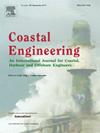Ship-induced wave forces on a moored ship in the presence of uniform current
IF 4.2
2区 工程技术
Q1 ENGINEERING, CIVIL
引用次数: 0
Abstract
Due to the increase in ship sizes and traffic, the effect of passing ships on the mooring forces of moored ships is becoming an increasingly more important aspect in restricted waterways, channels, and ports. The objective of the presented work is to investigate the effects of the presence of an ambient current on the hydrodynamic forces on moored ships when another vessel passes through the waterway.
In this research, XBeach-NH in (nonhq3d) mode is used to simulate passing ship effects, corresponding to test conditions as measured in physical model tests carried out at Deltares as a part of the JIP Ropes (Joint Industry Project, Research on Passing Effects on Ships) project (van der Hout and de Jong, 2014). Even though various layouts were tested in the Ropes project; the current paper focuses on the straight channel layout with different combinations of ship velocity and ambient current speed. Results show that XBeach slightly overestimates the draw down effects (water level depression) due to the primary waves, as well as the surge forces. And, the differences in surge forces between XBeach and measurement increases with increasing Froude number. However, sway forces and yaw moments are in better agreement with the measured data, even for higher Froude numbers, though slightly underestimated. This variation in results is consistent in almost all XBeach simulations. Results also indicate that ship velocities relative through water are more important than ship speed over ground in the presence of uniform current. However, in modelling exercises, it is advisable to run simulations implementing actual currents rather than simply adding or subtracting the current velocity to/from ship speed over ground to obtain a representative relative vessel through water, since in the latter case the duration of hydrodynamic force excitation on the moored vessel will not be realistic. Furthermore, simulations show that by only representing the correct relative speed through water in the simulations (and not the correct speed over ground), the surge force & yaw moment magnitude are underestimated in case of counter currents and sway forces are underestimated in case of following currents.
在有均匀水流的情况下,系泊船舶所受的船致波浪力
由于船舶规模和交通量的增加,在受限制的水道、航道和港口中,过往船舶对系泊船舶系泊力的影响越来越重要。本文的目的是研究当另一艘船舶通过水路时,环境电流对系泊船舶水动力的影响。在本研究中,使用(nonhq3d)模式下的XBeach-NH来模拟船舶通过效应,对应于JIP Ropes(联合工业项目,船舶通过效应研究)项目(van der Hout和de Jong, 2014)在Deltares进行的物理模型试验中测量到的试验条件。尽管在Ropes项目中测试了各种布局;本文主要研究船舶航速与环境航速不同组合条件下的直线型航道布局。结果表明,XBeach略微高估了由主波引起的下降效应(水位下降),以及浪涌力。并且,XBeach与测量之间的浪涌力差异随着弗劳德数的增加而增加。然而,摇摆力和偏航力矩与测量数据更加一致,即使对于更高的弗劳德数,尽管略有低估。这种结果的变化在几乎所有XBeach模拟中都是一致的。结果还表明,在均匀水流存在的情况下,船舶在水中的相对速度比在地面上的速度更重要。然而,在建模练习中,最好运行实际水流的模拟,而不是简单地将船舶在地面上的航速与航速相加或相减,以获得具有代表性的相对船舶通过水,因为在后一种情况下,对系泊船舶的水动力激励的持续时间是不现实的。此外,模拟表明,在模拟中只表示正确的通过水的相对速度(而不是正确的通过地面的速度),浪涌力&;在逆流的情况下,偏航力矩值被低估,在顺流的情况下,摇摆力被低估。
本文章由计算机程序翻译,如有差异,请以英文原文为准。
求助全文
约1分钟内获得全文
求助全文
来源期刊

Coastal Engineering
工程技术-工程:大洋
CiteScore
9.20
自引率
13.60%
发文量
0
审稿时长
3.5 months
期刊介绍:
Coastal Engineering is an international medium for coastal engineers and scientists. Combining practical applications with modern technological and scientific approaches, such as mathematical and numerical modelling, laboratory and field observations and experiments, it publishes fundamental studies as well as case studies on the following aspects of coastal, harbour and offshore engineering: waves, currents and sediment transport; coastal, estuarine and offshore morphology; technical and functional design of coastal and harbour structures; morphological and environmental impact of coastal, harbour and offshore structures.
 求助内容:
求助内容: 应助结果提醒方式:
应助结果提醒方式:


